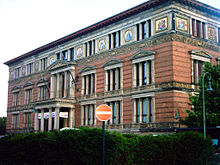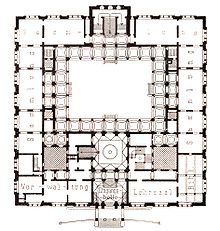- Martin-Gropius-Bau
-
 Front view from Niederkirchnerstraße in 2005
Front view from Niederkirchnerstraße in 2005
Martin-Gropius-Bau, originally a museum of applied arts and a listed historical monument since 1966, is a well-known Berlin exhibition hall located at Niederkirchnerstraße 7 in Berlin-Kreuzberg.
History and architecture
The building was erected between 1877 and 1881 by the architects Martin Gropius (a great uncle of Walter Gropius) and Heino Schmieden in an Italian Renaissance style. The ground plan is quadratic (length of each side c. 70 m; building height c. 26 m). The exhibition rooms surround an imposing atrium decorated with mosaics and the coats of arms of the German states.
Originally designed as a museum of applied arts, after World War I the building housed Berlin’s Museum for Prehistory and Early History and the East Asian Art Collection. It was severely damaged in 1945 during the last weeks of World War II, and reopened in 1981 after post war reconstruction beginning in 1978. Further renovation took place in 1998/1999 resulting in what is often described as one of Germany’s most beautiful historic exhibition buildings.
Until the end of the cold war in 1990 the building was close to the border between East and West Berlin, at the sector boundary to the East Berlin district “Mitte.” Now its central Berlin location, generous dimensions, and elaborate architectural decorations, not to mention the quality of its temporary exhibitions, have made it a major cultural and tourist attraction Across the street is the Berlin city and state parliament building (Abgeordneten Haus), originally built in 1899 to house the Prussian parliament; next door is the Third Reich documentation center Topography of Terror, and Potsdamer Platz is c. 100 m distant.
External links
Coordinates: 52°30′23″N 13°22′55″E / 52.50639°N 13.38194°E
Categories:- Art museums and galleries in Berlin
- Buildings and structures in Friedrichshain-Kreuzberg
- German museum stubs
- Berlin building and structure stubs
Wikimedia Foundation. 2010.

